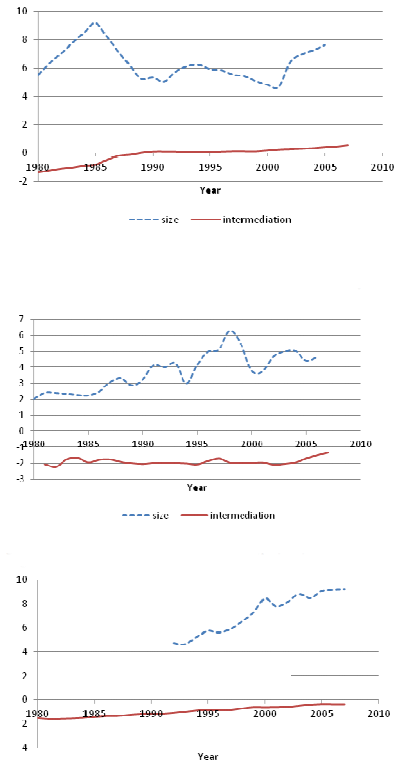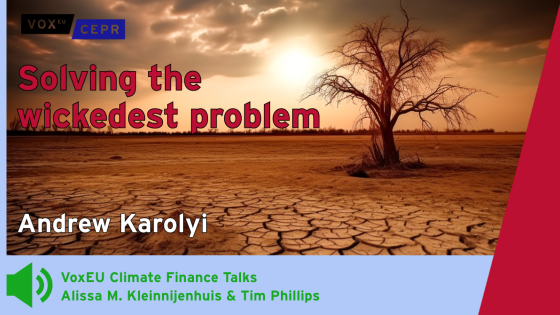The 2008 collapse of the Icelandic banking system and the current turmoil around the Cypriot banking system has shed significant doubt on the premise that more is better when it comes to finance:
- A considerable body of empirical evidence finds positive growth impacts of financial deepening;
- Recent evidence, however, has pointed to an insignificant or even negative effect of finance on growth in high-income countries.1
Sorting out the effects
In recent research, we contribute to this debate by gauging which conception of financial system – intermediation activities or size, including both intermediation and other auxiliary ‘non-intermediation’ activities – is relevant for real sector outcomes (Beck, Degryse and Kneer 2013). Specifically, using panel data across 77 countries, we investigate whether more intermediation services provided by banks and/or a larger financial system is associated with growth and volatility of GDP per capita.
Two views of the financial system
Our analysis is motivated by two different views of the role of finance in an economy:
- The financial system as facilitator for the rest of the economy versus.
The ‘intermediation or financial facilitator view’ emphasises the importance of the financial sector in mobilising funds for investment and contributing to an efficient allocation of resources across households and enterprises (i.e. the ‘traditional’ interest generating business). In doing so the financial sector supports capital formation and productivity growth, and ultimately economic growth. It also encompasses additional, more (or less) public services such as providing access to basic payment and transaction services that are important for the participation of the whole population in a modern market economy. The ‘intermediation or financial facilitator view’ thus highlights the role of the financial sector in facilitating the proper functioning of the modern market economy specifically in serving the other – non-financial – sectors of the economy.
- The financial system as a growth sector also performs non-intermediation activities.
A very different view is one that focuses on financial services as a growth sector in itself, thereby also performing many ‘to-the-home-country’ non-intermediation services. This view of the financial sector often presents it as an export sector, i.e. one that seeks to build a nationally centred financial centre, based on relative comparative advantages such as skill base, favourable regulatory policies, and subsidies. Economic benefits also include important spin-offs coming from professional services (legal, accounting, consulting) that tend to cluster around a financial centre.
We refer to this focus on financial services as a business because the ‘financial centre view’ encompasses intermediation but also non-intermediation activities. This also includes all ‘non-interest fee’ business stemming from the view of the financial system as an export sector.
Measuring financial sector size and intermediation
As a measure of financial intermediation, we use a standard indicator of the finance and growth literature, private credit to GDP (defined as the log of claims on the domestic private sector by deposit money banks as a share of GDP).
To gauge the size of financial systems, we use the value added share of the financial sector in GDP from the national accounts tables of the United Nations Statistics Division. We also base our size measure on sector J of ‘ISIC’, composed of financial intermediation, insurance funding, pension funding and activities auxiliary to financial intermediation. This includes traditional intermediation services such as loan provision to businesses and consumers, but also investment in securities for own account and on behalf of others as well as advisory services. This broad definition of the financial sector implies that our gross value added measure captures overall financial activity and encompasses both intermediation and non-intermediation activities.
Figure 1 shows the development of size and intermediation over time in the UK, Turkey and Mauritius respectively. These three countries illustrate the potential divergence between size and intermediation and highlight the importance of going beyond traditional measures of financial development. In the UK, for instance, the financial sector shrank from 9% to 5% of GDP from 1985 to 1990, while lending activities grew substantially over the same period. In the second half of the 1990s the financial industry shrank by another percentage point, but intermediation remained roughly constant. Only in the early 2000s did the UK financial system start to again increase significantly in size. Over the same period, Turkey witnessed an increase in financial-sector size, which was not accompanied by an expansion of intermediation activities. However, this overall increase in financial-system size was accompanied by a high volatility, possibly related to systemic distress the Turkish financial system experienced over this period. On the other hand, there are many countries like Mauritius in our sample where size and intermediation are both upward trending and move in par.
Figure 1. Evolution of size and intermediation in the UK, Turkey and Mauritius
Note: Size is the value-added share of the financial sector in GDP. Intermediation is the log of banks’ claims on the domestic private sector divided by GDP. The top, middle and bottom part of Figure 1 display the results for the UK, Turkey and Mauritius, respectively. Overall, we have used data for 77 countries for the period 1980 to 2007.
Empirical findings
- Over the long run, financial intermediation is positively associated with growth and negatively with growth volatility. Both effects have, however, become weaker over time. The overall size of the financial sector does not seem to be associated with long-run growth or volatility once we control for intermediation, suggesting that non-intermediation activities are not associated with long-run growth or volatility.
- Neither the size of the financial sector nor intermediation is related with growth over the medium run (i.e. over five-year periods) despite a positive growth effect of the size of the financial sector and the non-intermediation component in the subsample of high-income countries. In the medium run, intermediation and non-intermediation services have opposing associations with volatility. Intermediation stabilises the economy – a finding largely driven by the low-income countries in our sample, while non-intermediation services increase volatility – a finding mainly driven by the high-income countries.
Conclusions
In line with the financial-centre view, our results for high-income countries suggest that a large financial sector might stimulate growth in the short term. However, this comes at the cost of higher growth volatility. The recent experience of Iceland and Cyprus – and, to a lesser degree, of the UK and the Netherlands – support a more general finding, based on pre-crisis data. The financial facilitator function is especially powerful in developing and emerging markets, both for growth in the long term and reducing volatility in long and medium term.
Our research offers initial and tentative evidence on the different roles that intermediation and non-intermediation activities play in the growth process of countries, as well as on the importance of different financial-sector concepts. We leave issues of endogeneity and omitted variable biases for future research. This future research will hopefully rely on more micro-level data and rigorous identification strategies to disentangle the effects of different financial services and financial-system concepts.
References
Beck, Thorsten (2012), “Finance and growth – lessons from the literature and the recent crisis”, note prepared for the LSE Growth Commission, available at .
Beck, Thorsten, Hans Degryse, and Christiane Kneer (2013), “Is More Finance Better? Disentangling Intermediation and Size Effects of Financial Systems”, Journal of Financial Stability, forthcoming.
Levine, Ross (2005), “Finance and Growth: Theory and Evidence”, in Philippe Aghion and Steven N Durlauf (eds.) Handbook of Economic
Growth, Amsterdam, Elsevier, 865–934.
1 See Levine 2005 for an overview of the finance and growth literature and Beck 2012 for a discussion on the more recent finance-growth findings.







